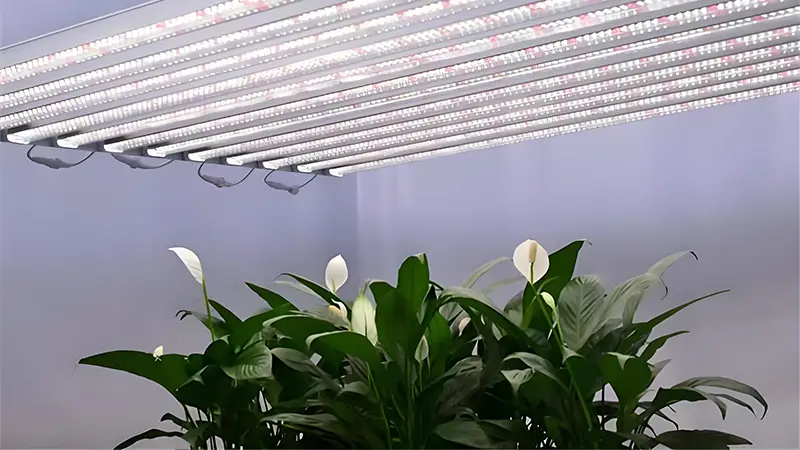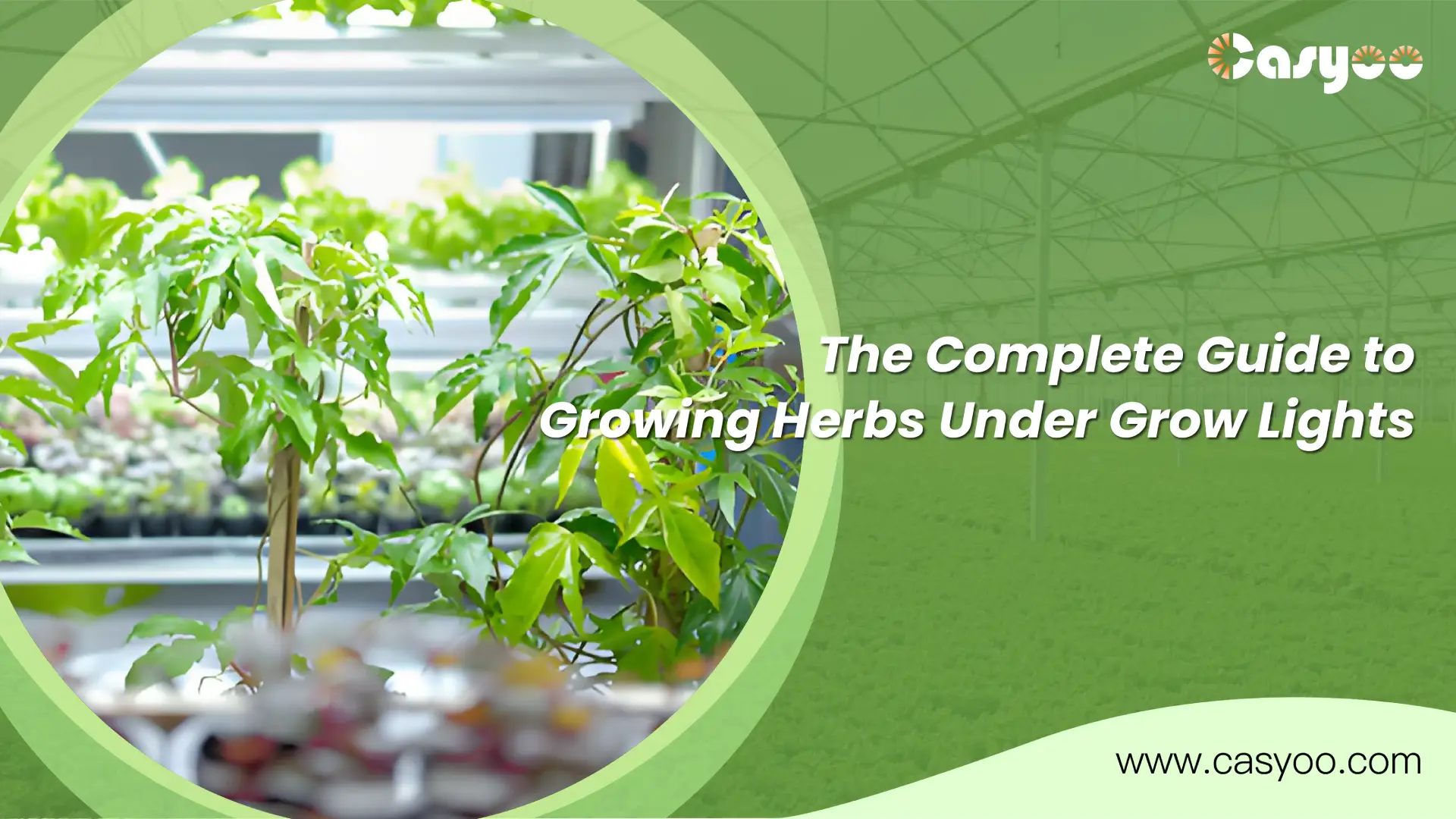Remember that sad basil plant stretching toward your window like a desperate gymnast? We’ve all been there. As a home cook who battled with north-facing windows for years, I discovered that herb grow light aren’t just for professional greenhouses – they’re a game-changer for anyone craving fresh herbs year-round.
No more watching $4 grocery store herb packets wilt in your fridge. Whether you’re dreaming of fresh pesto in December or mint for summer mojitos, growing herbs under lights is simpler than you might think. This guide will show you exactly how to set up your own indoor herb garden, even if you think you don’t have the space or the green thumb for it.
Ready to transform your cooking with fresh herbs 365 days a year? Let’s dig in.
Understanding Herbs’ Light Requirements
When I started growing herbs indoors, I was surprised to learn that different herbs need very different amounts of light. Just like people have different energy levels, herbs have their own light preferences that affect how well they grow and taste.
Strong Light Herbs (6+ hours)
Many popular cooking herbs originally come from sunny Mediterranean regions. These sun-lovers need the most light to develop their rich flavors and oils:
- Basil
- Rosemary
- Thyme
- Sage
- Oregano
Moderate Light Herbs (4-6 hours)
Not every herb demands intense light. These more adaptable plants can thrive with less direct light exposure, making them perfect for spaces that aren’t quite as bright:
- Mint
- Parsley
- Cilantro
- Tarragon
What Healthy Herbs Look Like
When herbs get the right amount of light, they develop distinct characteristics that tell you they’re thriving:
- Deep green leaves
- Sturdy stems
- Compact growth
- Strong aroma
Signs of Poor Light
Your herbs will quickly show you if they’re not getting enough light through several clear signals:
- Pale leaves
- Stretched stems
- Weak growth
- Mild flavor
I’ve found that keeping grow lights on for 14-16 hours in summer and 10-12 hours in winter creates the best results. Watch your plants – they’ll show you if they need more or less light through their growth patterns and appearance.
Setting Up Your Herb Growing Station
Basic Equipment Needs
Your indoor herb garden doesn’t need complex equipment to succeed. I started with a simple LED herb grow light, a $10 outlet timer, and some basic pots with drainage holes. The timer was actually my best early investment – it automated the light schedule so my herbs got consistent light even when I was too busy to remember. A small fan helps strengthen the stems and prevent mold, while good potting soil creates the foundation for healthy growth. You don’t need to buy everything at once; start with the basics and add as you go.
Location Planning
The perfect spot for your herbs isn’t about having lots of space – it’s about having the right conditions. My first successful setup was just a corner of my kitchen counter. Look for a stable surface where you can easily tend to your plants daily. You’ll need an electrical outlet nearby for your herb grow light, and make sure it’s away from heating vents or cold windows that could stress your plants. If you have cats like I do, consider a raised shelf or closed area to protect curious paws from nibbling your herbs.
Light Positioning
Light height is crucial but doesn’t need to be complicated. Too close, and your herbs can get leaf burn (I learned this the hard way with my first basil crop). Too far, and they’ll stretch to reach the light. Start with your light about 6 inches above seedlings, then raise it as your plants grow. Watch how your plants respond – if leaves start curling or looking bleached, move the light higher. If stems stretch up, lower the light a bit. It’s really about observing and adjusting.
Organization Tips
Think of your growing space like a tiny city where every plant needs the right neighborhood. Keep plants of similar heights together so taller ones don’t shade shorter ones. Put your sun-loving Mediterranean herbs like basil and rosemary in the brightest center spot. More shade-tolerant herbs like mint can go around the edges. Leave enough space between pots for air circulation and future growth. Most importantly, arrange everything so you can easily reach each plant for watering and harvesting. Your setup should work for you, not the other way around.
Growing Different Herbs
Easy Starter Herbs
If you’re new to indoor herb gardening, start with the forgiving ones. Basil was my first successful indoor herb – it grows quickly and tells you exactly what it needs. Mint is practically indestructible (sometimes too much so), while chives keep producing fresh growth even after multiple harvests. Parsley is another beginner-friendly choice that stays productive for months. These herbs will build your confidence while providing fresh flavors for your kitchen.
Mediterranean Herbs
These herbs need more attention but reward you with intense flavors. Rosemary, thyme, and sage come from hot, sunny regions and prefer similar conditions indoors. They need strong light, excellent drainage, and don’t like to be overwatered. I killed two rosemary plants before learning they prefer to dry slightly between waterings. Let these herbs’ natural habitat guide your care – think rocky Mediterranean hillsides, not tropical rainforest.
Annual vs Perennial
Understanding growth patterns helps you plan better. Annual herbs like cilantro and dill complete their lifecycle in one season – they’ll eventually flower and need replacing. That’s normal, not a failure. Perennial herbs like oregano, thyme, and sage can keep growing for years with proper care. Some herbs, like parsley, live for two years, flowering in their second season. Plan your planting schedule around these natural cycles.
Special Growing Notes
Each herb has its quirks. Cilantro bolts (flowers) quickly in warm conditions, so plant small batches every few weeks for continuous harvest. Basil grows best when you regularly pinch off the top leaves to encourage bushiness. Mint needs its own container because it spreads aggressively. Woody herbs like rosemary and thyme need pruning to stay compact and productive. Learning these individual needs makes a huge difference in your success rate.
Harvesting Under Grow Lights

Timing Your Harvests
The beauty of growing herbs under lights is having fresh harvests whenever you need them. I’ve learned that most herbs are ready for their first harvest when they’re about 6-8 inches tall and have several sets of leaves. Don’t rush this – I made that mistake with my first basil plant and it never really recovered. Wait until your plants are established and bushy before starting to harvest. Morning is the best time to harvest, when the plants are full of essential oils and flavors.
Proper Cutting Techniques
How you harvest makes a huge difference in future growth. Always use clean, sharp scissors or pruners – dull tools can crush stems and damage the plant. Cut just above a set of leaves or a growth node (where leaves meet the stem). This encourages the plant to branch out at that point, creating a bushier plant. Avoid taking more than a third of the plant at once, giving it enough leaves to keep growing strong.
Promoting Continued Growth
Regular harvesting actually helps herbs grow better under lights. When you cut herbs correctly, you’re essentially pruning them, which signals the plant to produce more branches and leaves. Remove any flowers unless you’re saving seeds – flowering can make herbs bitter and reduce leaf production. For basil, pinch off the top growth to prevent flowering and encourage side branching.
Storage Tips
One advantage of growing under lights is harvesting exactly what you need, when you need it. But sometimes you’ll have extra. Fresh herbs store best wrapped loosely in slightly damp paper towels and placed in a plastic bag in the refrigerator. I’ve found hard-stemmed herbs like thyme and rosemary can last two weeks this way, while soft herbs like basil and parsley should be used within a week. Or try drying extra herbs under your herb grow light for future use.
Advanced Tips
Light Manipulation
After mastering the basics, I discovered how tweaking light schedules can enhance growth. Increasing light duration before you need a big harvest (like before a dinner party) can boost production. But avoid sudden changes – I lost a thriving oregano plant by abruptly increasing its light exposure. Instead, add 30 minutes every few days. For flowering herbs like Thai basil, reducing light hours can trigger blooming if you want to save seeds. Just remember that any light schedule changes should be gradual.
Propagation Under Lights
Growing from cuttings is incredibly rewarding and cost-effective under herb grow light. Start with easy herbs like mint, basil, or oregano. Take 4-inch cuttings just below a leaf node, remove lower leaves, and place in water or moist soil. Keep them under lower light initially – I learned the hard way that too much light can stress cuttings. Once they develop roots and new growth, gradually increase light exposure. Within weeks, you’ll have new plants to expand your garden or share with friends.
Managing Microclimates
Your growing space has different temperature and humidity zones. The area closest to lights is warmer and drier – perfect for Mediterranean herbs like rosemary and sage. Lower shelves are cooler and more humid, better for moisture-loving herbs like mint and parsley. I use these natural variations to my advantage, placing herbs where they’ll be happiest. A small temperature gauge can help you map these microclimates.
Seasonal Adjustments
Even indoors, herbs respond to seasonal changes. During winter months, growth naturally slows. Reduce watering slightly, but maintain light duration to prevent leggy growth. In summer, you might need to increase air circulation and watering. Some herbs, like basil and cilantro, may need replacing more often in summer as they flower quickly. Working with these natural rhythms, rather than fighting them, leads to healthier plants.




